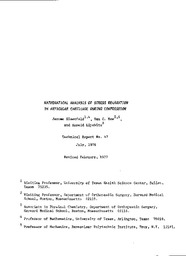
ATTENTION: The works hosted here are being migrated to a new repository that will consolidate resources, improve discoverability, and better show UTA's research impact on the global community. We will update authors as the migration progresses. Please see MavMatrix for more information.
Show simple item record
| dc.contributor.author | Eisenfeld, Jerome | en |
| dc.contributor.author | Lipshitz, Harold | en |
| dc.contributor.author | Mow, Van C. | en |
| dc.date.accessioned | 2010-06-01T18:55:39Z | en |
| dc.date.available | 2010-06-01T18:55:39Z | en |
| dc.date.issued | 1977-02 | en |
| dc.identifier.uri | http://hdl.handle.net/10106/2211 | en |
| dc.description.abstract | **Please note that the full text is embargoed** ABSTRACT: Articular cartilage is the avascular bearing material covering the articulating ends of the mating bony segments of synovial joints. Functionally articular cartilage provides a near frictionless surface, whose coefficient of friction 0.002, which is tough and wear resistant. These biomechanical functions of the tissue are preserved so long as the tissue is maintained in a normal physiological state. The destruction and subsequent loss of articular cartilage as a result of degenerative joint diseases would lead to joint stiffness, pain and deformities. An abnormal state of mechanical stress exerted upon the tissue is an initiating factor or at least a precursor of chondrodegeneration [9]. The morphology of pre-clinical ultrastructural damage, resulting from biomechanical causes, of the surface collage fibers from human femoral heads have been investigated and codified [8]. These alterations are believed to be mechanically induced and are related therefore to the inherent mechanical properties of the tissue. | en |
| dc.language.iso | en_US | en |
| dc.publisher | University of Texas at Arlington | en |
| dc.relation.ispartofseries | Technical Report;47 | en |
| dc.subject | Articular cartilage | en |
| dc.subject | Stress relaxation | en |
| dc.subject | Biphasic rheological model | en |
| dc.subject.lcsh | Biomechanics | en |
| dc.subject.lcsh | Mathematics Research | en |
| dc.title | Mathematical Analysis of Stress Relaxation in Articular Cartilage During Compression | en |
| dc.type | Technical Report | en |
| dc.publisher.department | Department of Mathematics | en |
Files in this item
- Name:
- MathTechReport047.pdf
- Size:
- 919.7Kb
- Format:
- PDF
- Description:
- PDF
This item appears in the following Collection(s)
Show simple item record


